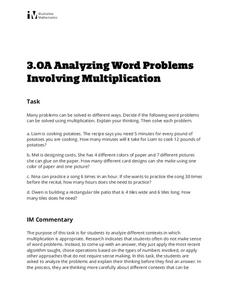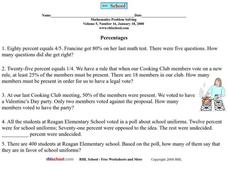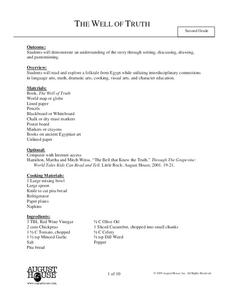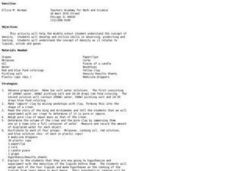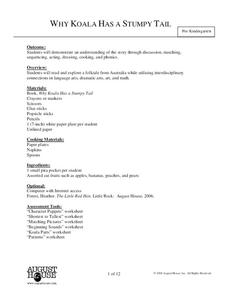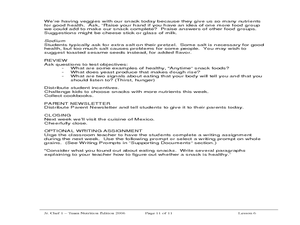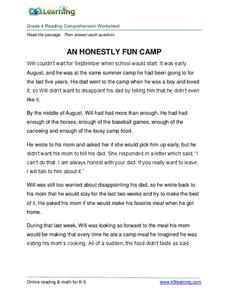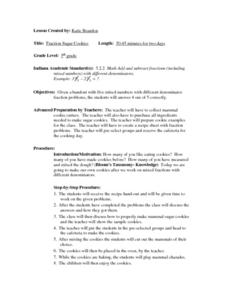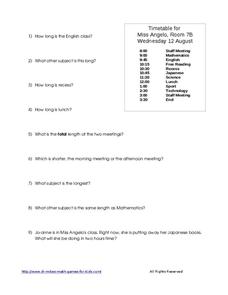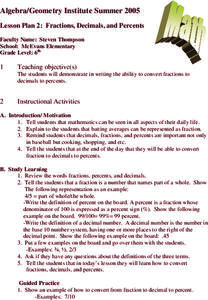Curated OER
Blast the Fats
Students examine the fats found in foods. In this nutrition lesson, students identify the types and amounts of fats found in foods as they research food labels and the Internet. Students classify the fats and record their data.
Curated OER
Analyzing Word Problems Involving Multiplication
Learners sometimes have difficulty making sense of a word problem. In a guided learning activity, pupils are asked to think about how to find an answer and explain their thinking, rather than finding the answer. It allows them to...
Curated OER
Understanding Fractions - Cookbook Comparisons
Learners explore equal fractions in relationship to a whole unit. They fold strips of paper into halves, thirds, etc. and compare them to the first strip which represents a "whole unit." Fractional parts are identified and compared.
Curated OER
Hot Off the Grill
Students read an article about humans getting sick from eating improperly cooked meat. In groups, they cook a hamburger patty and when they believe it is done, they check the temperature with thermometers. They record their temperatures...
Curated OER
Percentages
In this percentages activity, students problem solve five mathematical word problems associated with percents and percentages.
Curated OER
Water Use Around the World
Students compare their water use with other places around the world. They calculate the amount of water they use in a week and discuss how to conserve water. They discover the amount of clean water throughout the world.
Curated OER
The Mister Runtles' Bet
Students listen to a story dealing with exponential and linear growth. After reading the story, students complete a table comparing information. Using a calculator, students graph the rice and daily population of flies. They study the...
Curated OER
The Well of Truth
Second graders explore the Egyptian folktale, The Well of Truth. In this folktale lesson, 2nd graders read the tale and discuss the events from the text. Students write a diary entry from the point of view of a character in the text....
Curated OER
Densities
Students explore the concept of density. In this density lesson plan, students determine the density of a crown and a sample of clay. They hypothesize about the densities of 4 liquids they are given including molasses, cooking oil, a red...
Curated OER
Why Koala Has A Stumpy Tail
Students practice reading comprehension of an Australian folktale. In this Australian folktale lesson, students read the story, Why Koala Has a Stumpy Tail, before completing retells with character puppets, discussing friendship, and...
Curated OER
The Kindness Company
Students organize themselves into a simulated company complete with applications, interviews and training. They identify a community need they can fulfill related to cooking or sewing and work to make and deliver the designated product.
Curated OER
What Does it Take to be a Survivor? Part One
Young scholars explore marine animal adaptation. In this introductory ocean life biology instructional activity, students access prior knowledge by participating in a whole class "thought swap." Young scholars form two lines, respond to...
Curated OER
Jr. Chef Club Super Snacks Lesson 6
Students explore healthy snacks. In this nutrition and cooking lesson, students observe and identify food groups on USDA's MyPyramid food guide. Students discuss how fiber helps our digestive system and follow a recipe using yeast to...
Curated OER
Comparison of Adjectives
For this comparative and superlative adjective online worksheet, students watch two YouTube videos about the different types of adjectives. They fill in the blanks in 20 sentences with the correct comparative adjectives. They complete a...
Curated OER
Reading, Writing, And Math in Daily Living
Students, in groups, make chocolate chip cookies following a recipe.
K5 Learning
An Honestly Fun Camp
Six short answer questions challenge scholars to show what they know after reading a passage about a boy not so keen on his first trip to summer camp.
San Francisco Public Utilities Commission
Water from the Well
How much water does it take to brush your teeth? How about to wash your clothes? Perform an experiment that measures water usage in everyday tasks and compares them to the days before indoor plumbing, specifically the California gold...
Energy for Keeps
Going for a Spin: Making a Model Steam Turbine
Discover the effectiveness of wind, water, and steam as energy sources. The hands-on activity has young scientists create a turbine from common materials. After constructing the turbines, they use wind, water, and steam to turn them and...
Curated OER
Fraction Sugar Cookies
Fifth graders practice addition, subtraction,and conversion of fractions by making cookies from a recipe. Students convert mixed number into compound fractions and combine fractions using addition in order to make a certain amount of...
Curated OER
Timetable: subjects for the day
In this time table worksheet, students view the subjects and schedules for different classes for the day and answer time related questions about them. Students look at 4 schedules and answer 31 questions total.
Curated OER
Tzedakah: How Can We Help?
Young scholars define what constitutes a nutritious meal, the price of a healthy meal, and understand that some people can't afford healthy meals. In this healthy meals instructional activity, students estimate and research the cost of a...
Curated OER
Prime and Composite Numbers
Sixth graders identify prime and composite numbers and complete an activity problem. Given a 100 chart, they follow directions to create a prime number chart. In groups, 6th graders play a "Prime Take Away" activity to reinforce prime...
Curated OER
Fractions, Decimals, and Percents
Sixth graders engage in a lesson that explores the conversion process of fractions, decimals, and percents in relationship to their values to each other. Students demonstrate how to convert numbers interchangeably between fractions,...
Curated OER
Cups, Pints, Quarts and Gallons
In this measurement instructional activity, students circle greater amounts, and estimate and measure items to the nearest unit. Houghton Mifflin text is referenced.



